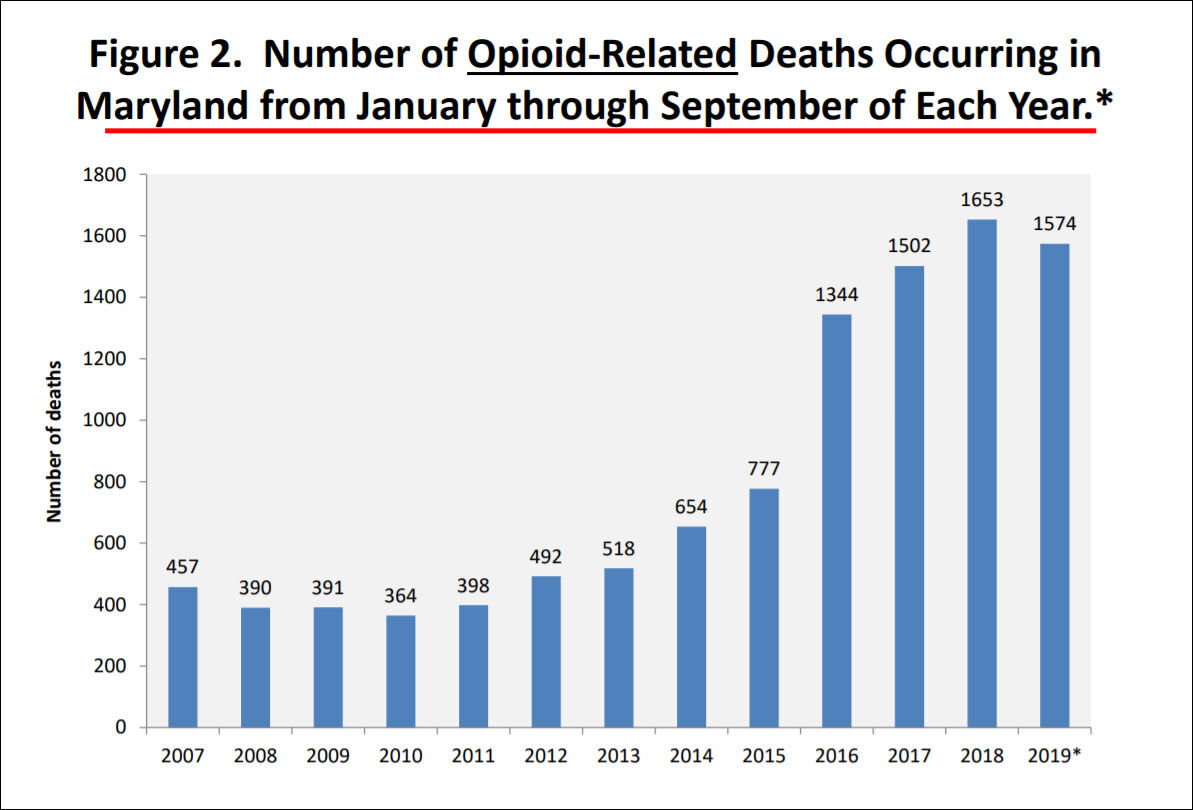For the first time in a decade, Maryland has seen a slight decrease in the number of deaths caused by opioid overdoses.
From January through September 2019, the state recorded 1,574 deadly opioid overdoses — 79 deaths fewer than the same period in 2018, according to numbers released by the Maryland Department of Health.
“We are making progress, but it is not quick enough,” said Steve Schuh, the executive director of Maryland’s Opioid Operational Command Center.
According to the preliminary numbers, Anne Arundel County saw the biggest decline in opioid overdose deaths during the period, with 137 deaths. That’s 41 fewer deaths than in 2018. In Prince George’s County, deaths decreased from 67 to 65. Howard County saw 23 deaths, down four from the previous year.
Not all places saw decreases: In Montgomery County, the number of people who died of opioid overdoses rose to 66 people, compared to 57 last year. Baltimore also saw a spike during the period, from 609 to 639 deaths.

Among all opioid overdose deaths, fentanyl remained the biggest killer.
In 2019, the synthetic opioid caused the deaths of 1,436 people, and accounted for 90% of the state’s opioid intoxication deaths.
“Fentanyl is the most frightening aspect of this entire public health epidemic,” Schuh said.
Fentanyl is 50 times more powerful than heroin, he said, and has become a “primary actor” in all the state’s opioid cases where people have died.
The substance is being added to a number of drugs, including cocaine and heroin. “Whatever you buy off the street, it is very likely to include fentanyl and it is very likely to kill you,” Schuh said.
New plan: Expanded access to treatment services
In 2017, Maryland Gov. Larry Hogan declared a state of emergency over the opioid crisis, and that led to the creation of the Opioid Operational Command Center, which now leads the statewide response.
Schuh’s department recently released its plan to get the state’s 24 jurisdictions on the same page and get them the resources they need to battle the epidemic. The plan, Schuh said, focuses around several areas, including prevention, education, enforcement, public safety and treatment, as well as recovery.
Among the steps to be taken are gathering more information about the crisis, and expanding access to substance abuse and mental health services for those fighting addiction.
The state will also place an emphasis on helping those behind bars, and that includes jails to abide by H.B. 116, which requires inmates to be examined for mental illness and substance abuse and, if needed, help them obtain treatment.
Though targeting the drug supply is important, the state said it also is looking at arrest diversion programs in which law enforcement, instead of arresting someone in crisis, divert them to resources that can help them.
More wellness centers and so-called sober homes where people can live in drug-free environments are also goals for the state. “Where people can go and live healthy and productive lives, and not be lured back into the dark world of addiction,” Schuh said.
Another important factor, according to the plan, is harm reduction, which includes distributing the opioid overdose reversal drug Naloxone, and helping other local jurisdictions and community organizations with providing wound care treatment and fentanyl test strips.
Schuh said one problem his center is also addressing is making sure everyone in the state, no matter where they live, have the services they need to get better. “There are jurisdictions that have more treatment options, more developed programs than others,” Schuh said.
When it comes to the 2019 numbers, Schuh said that while the slight decline is encouraging, Maryland has much more work to do.
“We do believe that the right strategies are in place, but it’s going to take time to prevail against this very powerful and destructive adversary,” Schuh said.








